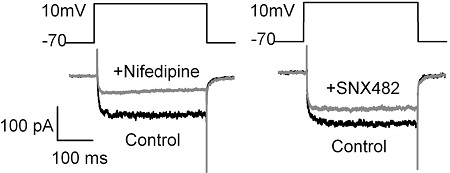Overview
- Furukawa, T. et al. (1999) J. Pharmacol. Exp.Ther. 291, 464.
- Sorkin, E.M. et al. (1985) Drugs 30, 182.
- Lundy, A. et al. (2009) Vasc. Health Risk Mang. 5, 429.
 Alomone Labs Nifedipine blocks L-type Ca2+ currents in Xenopus oocytes.A. Time course of L-type channel (CaV1.2+α2δ1+β1a) activity before and during applications of 0.1, 0.5, 1, 2, and 10 μM Nifedipine (#N-120) as indicated, and upon wash. Holding potential was -80 mV and currents were elicited every 10 seconds by 100 ms ramp to +50 mV. B. Superimposed current traces of L-type channels (CaV1.2+α2δ1+β1a), before and during applications of 0.1, 1 and 10 μM Nifedipine as indicated. Holding potential was -100 mV and currents were elicited every 10 seconds by 100 ms steps to +10 mV.
Alomone Labs Nifedipine blocks L-type Ca2+ currents in Xenopus oocytes.A. Time course of L-type channel (CaV1.2+α2δ1+β1a) activity before and during applications of 0.1, 0.5, 1, 2, and 10 μM Nifedipine (#N-120) as indicated, and upon wash. Holding potential was -80 mV and currents were elicited every 10 seconds by 100 ms ramp to +50 mV. B. Superimposed current traces of L-type channels (CaV1.2+α2δ1+β1a), before and during applications of 0.1, 1 and 10 μM Nifedipine as indicated. Holding potential was -100 mV and currents were elicited every 10 seconds by 100 ms steps to +10 mV.
Native voltage-gated Ca2+ channels (VGCC, CaV) are pharmacologically classified into at least five different subclasses (L-, N-, P-, Q-, and R-type), the characteristics of which are determined by the pore-forming a1 subunit. The subunits CaV1.1-1.4 (α1S, α1C, α1D and α1F) form L-type Ca2+ channels and bind dihydropyridines (DHPs) with high affinity.1-3 Nifedipine, a DHP, is a selective L-type Ca2+ channel blocker3. 10 µM Nifedipine inhibits ~65% of the L-type channel current at a holding potential of -80 mV, in Xenopus oocytes3.
Nifedipine was initially developed for the prophylaxis of angina symptoms, and then later used as an anti-hypertensive agent4. Nifedipine acts by inhibiting the transmembrane influx of calcium into cardiac and vascular smooth muscle cells, thus reducing muscle contraction and has predominantly vasodilatory effects on arteries with minimal effects on the myocardium and cardiac conduction5. For the same reason Nifedipine is also useful in the reduction of the frequency and severity of the attacks in Raynaud’s phenomenon, an episodic vasospasm of the peripheral arteries6.
Uterine contractions are the most frequently recognized symptom and sign of preterm labor and hence, inhibition of uterine contractility with tocolytic agents to prolong pregnancy and reduce neonatal complications continues to be the focus of treatment of preterm labor. The efficacy and safety of Nifedipine as a tocolytic agent in women with preterm labor were determined and provide another indication for Nifedipine7.

Alomone Labs Nifedipine and SNX-482 block L-type and R-type CaV channels respectively in rat pancreatic INS-1 832/13 β-cells.Representative CaV currents from INS-1 832/13 cells before and after treatment with Nifedipine (#N-120), a general L-type CaV channel blocker and SNX-482 (#RTS-500), a CaV2.3 channel blocker. 52% of the currents were blocked by Nifedipine (n = 8; p < 0.05) while 31% (n = 10; p < 0.001) of currents were blocked by SNX-482. Cells were held at −70 mV for 2 min after formation of whole-cell mode, and currents elicited by stepped 300 or 500 milliseconds depolarizations in 10 mV increments.Adapted from Xie, L. et al. (2016) PLoS ONE 11, e0147862. with permission of PLoS.

